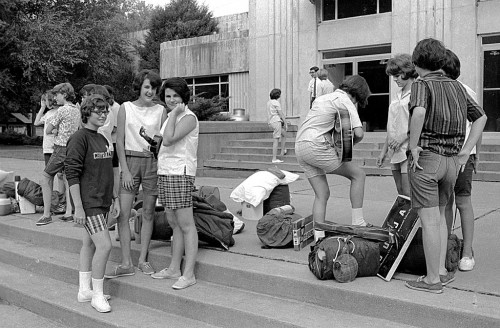 When I first ran across the photos of this giggle of girls in front of the Arena Building, I thought they might be refugees from some kind of band camp. One girl is strumming on a guitar, there’s at least one other guitar case there, and another girl has what appears to be a ukulele under her arm.
When I first ran across the photos of this giggle of girls in front of the Arena Building, I thought they might be refugees from some kind of band camp. One girl is strumming on a guitar, there’s at least one other guitar case there, and another girl has what appears to be a ukulele under her arm.
Ouija Boards and sleeping bags
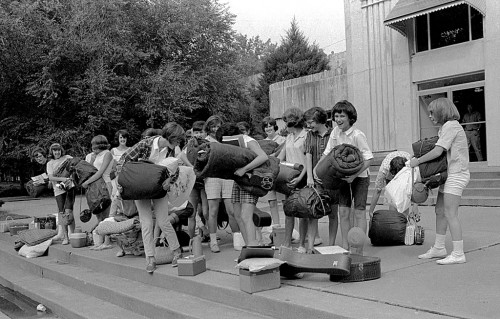 Then I noticed a Careers board game, a Ouija Board, sleeping bags, canteens and other camping paraphernalia.
Then I noticed a Careers board game, a Ouija Board, sleeping bags, canteens and other camping paraphernalia.
Is this a Girl Scout campout?
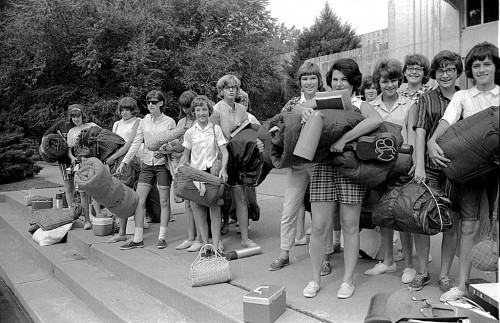 If it is, they certainly don’t travel light. They appear to be a thirsty bunch, too. I see canteens of various shapes, thermos bottles, an insulated jug and a pitcher. Those square boxes look like they might contain beauty aids. Or ham sandwiches.
If it is, they certainly don’t travel light. They appear to be a thirsty bunch, too. I see canteens of various shapes, thermos bottles, an insulated jug and a pitcher. Those square boxes look like they might contain beauty aids. Or ham sandwiches.
Headed INTO the Arena Building
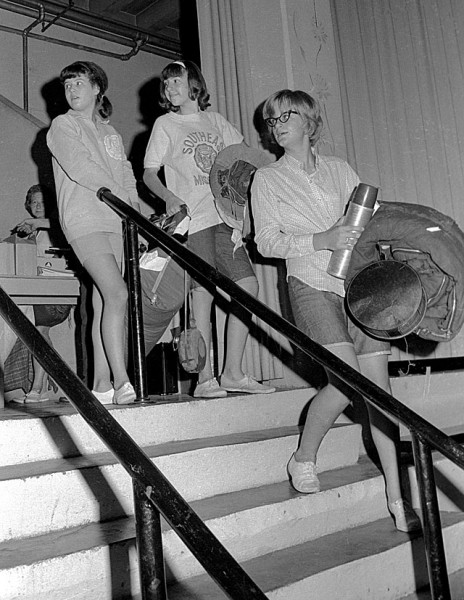 They weren’t meeting in front of the Arena Building to go somewhere, they were headed INTO the building. That’s interesting. If you have really sharp eyes, you can see a Civil Defense triangle on a box on the table at the top of the stairs. Maybe that’ll provide a clue to what’s going on.
They weren’t meeting in front of the Arena Building to go somewhere, they were headed INTO the building. That’s interesting. If you have really sharp eyes, you can see a Civil Defense triangle on a box on the table at the top of the stairs. Maybe that’ll provide a clue to what’s going on.
What is that on her head?
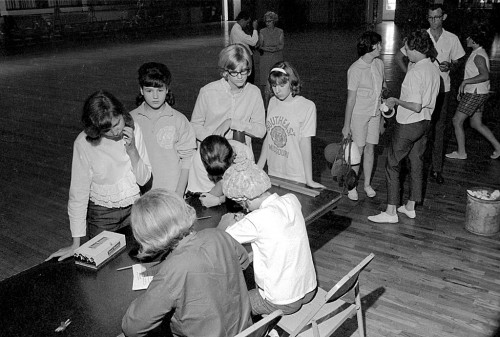 There is some kind of signing up going on here. I covered lots of Boy and Girl Scout events, but I don’t every recall running into the ceremonial or protective headgear the girl at the table is wearing.
There is some kind of signing up going on here. I covered lots of Boy and Girl Scout events, but I don’t every recall running into the ceremonial or protective headgear the girl at the table is wearing.
Elaborate forms to fill out
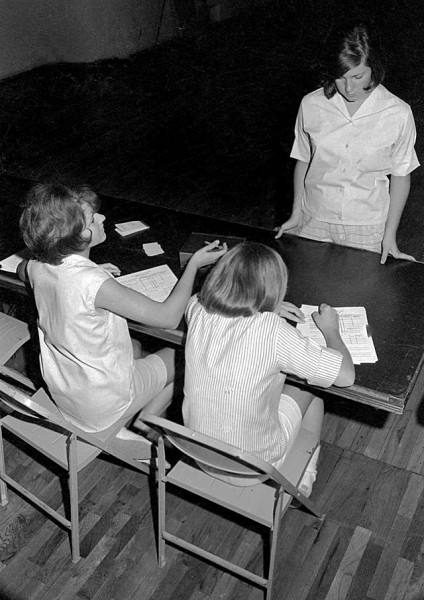 The forms these girls are holding look more formidable than the ones we face on April 15 every year. What ARE they up to?
The forms these girls are holding look more formidable than the ones we face on April 15 every year. What ARE they up to?
Civil Defense and National Security
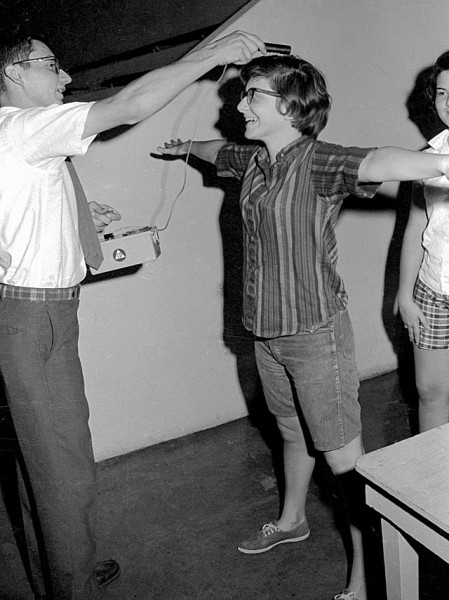 Then, I finally found the two frames that made it all clear. Notice the small box with the Civil Defense triangle on it the man is holding? It’s a Geiger Counter.
Then, I finally found the two frames that made it all clear. Notice the small box with the Civil Defense triangle on it the man is holding? It’s a Geiger Counter.
You have to remember that this was at the confluence of The Red Scare and the Dawn of Rock and Roll, you know, Devil’s Music.
The girls were suspected of being Radio Active
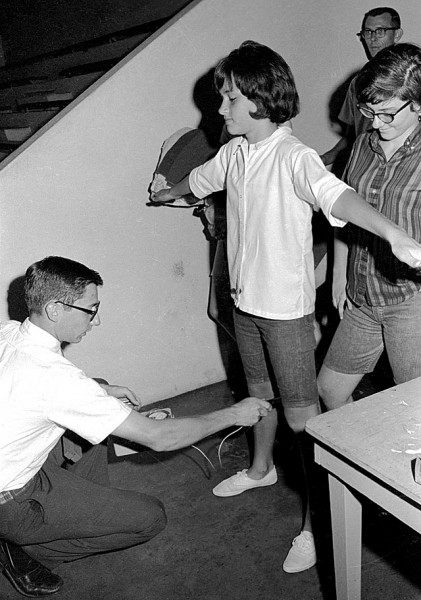 Some busybody neighbor must have heard these girls listening to rock n roll on the radio and passed the word to the local Civil Defense office. The message got garbled at each stage along the way until it finally read, “Scores of teenage girls in Cape Girardeau are radioactive.”
Some busybody neighbor must have heard these girls listening to rock n roll on the radio and passed the word to the local Civil Defense office. The message got garbled at each stage along the way until it finally read, “Scores of teenage girls in Cape Girardeau are radioactive.”
The next thing you know, buses were dispatched to snatch the girls and quarantine them in the Arena Building until they could be screened with Geiger Counters.
That’s my theory and I’m sticking to until someone can come up with a better one.

I recognize Betsy Foster, now Rigdon, and Sue Jackson. My guess is girl scouts.
Oh, my…all those Keds on their feet! The shoe of the day!
I recognize almost everyone in these photos. They are from the class of 1969 and 1970.
I think they were spending the night in a bomb shelter.
In the third to the last photo of the girl standing at the table, that is Becky Bender.
I will try to identify more for you later, but I know almost all of them.
Actually, they are all girls from the CHS class of 1969.
You know what would make this story better? A mushroom cloud shaped cake from 1946 to celebrate the success of the atomic bomb program.
Cheers,
Matt
I did a Google Archive search for the terms Civil Defense and Arena Park trying to find the story the pix went with.
It was scary to be reminded of the days when families were encouraged to build fallout shelters (and subsidies were considered to help pay for them).
Remember, our generation grew up in the day of Duck and Cover.
There was one drill where the local CD had originally planned on setting off an explosive device with smoke, but decided not to, since most of the danger in Cape would be from radioactive fallout, not the blast.
By the late 60s, the Civil Defense role and drills had shifted to natural disasters like tornadoes and floods.
Ken, I think that two of the gals in the first photo were flirting with you…
They were still high from their radio active exposure to Devil Music.
Today, that last Geiger counter shot might be used as evidence in a sexual harassment case.
That thought crossed my wicked mind, too.
I noticed that the tester was brandishing the wand in a very tentative manner. The expression on the subject’s face clearly says, “OK, to the knee, but no higher.”
That is my sister, Ginny Grace. She was in the class of ’69, though we moved away after her sophomore year.
For some high school classroom assignment (I’m guessing), I interviewed the head of Civil Defense (she lived behind us on Themis Street, where “Bobby” Ravenstein had lived before). She gave me a thorough education of Civil Defense, bombs, pictures, descriptions, etc. and for years and years afterward I had vivid dreams (nightmares) of bomb blasts. Add that to my memories of the 1949 tornado and who needs scary movies?
I did volunteer work at Civil Defense in the early 60s, and I still have a stash of the handouts that I’m going to scan one of these days.
Looking back on it, I have the feeling that all of that stuff made us about as safe as a TSA screening at the airport does today.
Julia Howes is in the last two photos
Didn’t know the Arena had hardwood floors. Maybe someday if you have the data on the building a bit of history about it would be interesting.
Busybody neighbors??? Really?
David,
You have me questioning myself, but I know the outside photos are the Arena Building.
Take a look at these photos from a Cub Scout Pinewood Derby at the Arena Building. If you look closely, you can see the wood floor.
David,
I was hunting for something else tonight an ran across a Missourian story from June 20, 1967, that said the old wooden floors were being removed as part of a renovation program. A backhoe was used at first, then they talked about moving in a Cat to crush the wood, which would then be taken out in pieces. The cost of salvaging the wood was greater than it was worth.
After the floor was stripped to concrete in the main auditorium, restrooms and foyers, a terrazzo floor was going to be installed.
My pictures were shot before the renovation.
I recall my dad having a box of items and an ID of some kind for being a shelter manager for the Arena Building. There were rolls of filmstrips that he was to show in the event of an attack. I will see what I can find…
Our Girl Scout troop spent the night at the Arena to simulate life in a bomb shelter. As I recall, we drank only water and ate something resembling graham crackers. Since I don’t recognize all the girls, I’m guessing that more than one troop was there.
I attended SEMO from 1968-1972. Thanks for making some of the interesting sights and information available. I have fond memories of living in Cape Girardeau during those years.
I was one of those girls. Yes, we were there to spend the night in a “bomb shelter.” We Girl Scouts were particiating in an event to “Be Prepared” for such a catastrophe…remember those were the days folks were actually building bomb shelters in their homes. I rember that we ate special crackers made for emergency food and played games all night.
I remember spending the night at the Arena Building bomb shelter. As I remember we went down a hall that was to the west of the stage to a lower level. There was water and some sort of no taste cracker/cookie. But I don’t see anyone from my Girl Scout troop (class of ’70), so we must have gone a different time. The girls I recognize are all from the class of ’69. I don’t remember too much about the night. But I remember the yellow triangles and black signs that said Fallout Shelter and the atmosphere was more along the lines of a bunking party than being properly scared about the risk of ever having to use one of them. It used to be a pastime of my Dad’s to take us to see the special displays of bomb shelters by the local lumber companies. I was properly impressed by them and the idea of spending any length of time with my family in one of those things was daunting. Yikes!
Thanks for this interesting post. I will be sure to get the word out about this site 🙂 Excellent post. Can’t wait to see the next article.
The Arena Building was constructed as part of the WPA Program during the early 1930’s – part of FDR’s putting people back to work effort during the Great Depression.
Interesting, isn’t it how many of those “make work” projects that were so opposed as being socialistic boondoggles served the public for decades, in some cases to the present day?
The Jackson Football Stadium, Lorimier School, the old Jackson Swimming Pool, Houck Stadium are the first to come to mind.
There’s a well-manicured public housing project a few blocks from my home that was built in that period, primarily for older folks. I wonder how many thousands of seniors lived out their last years in comfort because of FDR’s decision to put people back to work building it.
The Arena Building was used as the National Guard Armory from the time it was constructed until the present NG facility was completed in the late 1950’s. Also, it was used by the Highway Patrol for a drivers license facility. That’s were I took my wriitten test and got my learners permit on my 16th birthday in 1958.
I also played many pick up basketball games on the wood floor of the basket ball court in the building. It was open for play after school and on Saturdays if it was being used for official business during the 50’s. The local kids loved it.